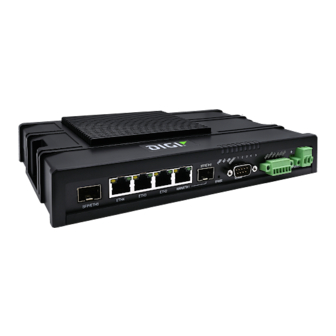
Digi IX40 5G Edge Router Manuals
Manuals and User Guides for Digi IX40 5G Edge Router. We have 1 Digi IX40 5G Edge Router manual available for free PDF download: User Manual
Digi IX40 User Manual (1024 pages)
Brand: Digi
|
Category: Network Router
|
Size: 35 MB
Table of Contents
-
Learn more79
-
Interfaces80
-
Disable Surelink114
-
Delete a LAN191
-
DHCP Servers192
-
Bridging220
-
Serial Port229
-
Routing297
-
IP Routing298
-
Routing Services321
-
Dynamic DNS325
-
Vrrp330
-
Configure VRRP331
-
Configure VRRP334
-
Ipsec354
-
Ipsec Mode354
-
Ipsec Modes354
-
Authentication355
-
Openvpn416
-
Show GRE Tunnels460
-
L2Tp482
-
L2TP with Ipsec492
-
L2Tpv3 Ethernet494
-
Macsec499
-
Nemo502
-
Show NEMO Status507
-
Configure DNS537
-
Show DNS Server542
-
WAN Bonding543
-
SNMP Security555
-
Download Mibs560
-
Modbus Gateway590
-
System Time607
-
Python Modules653
-
Local Users728
-
Ldap752
-
Packet Filtering788
-
Web Filtering806
-
Downgrading852
-
Enable FIPS Mode872
-
Intelliflow892
-
File System909
-
View System Logs925
-
View Event Logs927
-
Safety Warnings960
-
English960
-
French--Français962
-
Polish--Polskie965
-
Slovak--Slovák966
-
Spanish--Español968
-
The Help Command974
-
Show Config980
-
Show System980
-
Show Network980
-
Analyzer Clear996
-
Analyzer Save996
-
Analyzer Start996
-
Analyzer Stop996
-
Cat996
-
Container Create997
-
Container Delete997
-
Grep998
-
Help998
-
Mkdir1000
-
Modem at1000
-
Modem At-Interactive1000
-
Modem Firmware Check1000
-
Modem Firmware List1000
-
Modem Pin Change1002
-
Modem Pin Disable1002
-
Modem Pin Enable1003
-
Modem Pin Status1003
-
Modem Pin Unlock1003
-
Modem Puk Status1003
-
Modem Puk Unlock1004
-
Modem Reset1004
-
Modem Scan1004
-
Modem Sim-Slot1004
-
Modem Sms Send1005
-
Monitoring1006
-
More1006
-
Ping1006
-
Poweroff1007
-
Reboot1007
-
Scp1008
-
Show Analyzer1008
-
Show Arp1008
-
Show Cloud1008
-
Show Config1009
-
Show Containers1009
-
Show Dhcp-Lease1009
-
Show Dns1009
-
Show Eth1009
-
Show Event1010
-
Show Hotspot1010
-
Show Ipsec1010
-
Show L2Tp Lac1010
-
Show L2Tp Lns1011
-
Show L2Tpeth1011
-
Show Location1011
-
Show Log1011
-
Show Manufacture1011
-
Show Modbus-Gateway1012
-
Show Modem1012
-
Show Mqtt1012
-
Show Nemo1012
-
Show Network1013
-
Show Ntp1013
-
Show Openvpn Client1013
-
Show Openvpn Server1013
-
Show Route1014
-
Show Scep-Client1014
-
Show Scripts1014
-
Show Serial1014
-
Show Surelink Ipsec1015
-
Show Surelink State1015
-
Show System1015
-
Show Usb1016
-
Show Version1016
-
Show Vrrp1016
-
Show Wan-Bonding1016
-
Show Web-Filter1016
-
Speedtest1017
-
Ssh1017
-
System Backup1017
-
System Factory-Erase1018
-
System Find-Me1019
-
System Restore1020
-
System Script Start1020
-
System Script Stop1020
-
System Serial Clear1021
-
System Serial Save1021
-
System Serial Show1021
-
System Time Set1022
-
System Time Sync1022
-
System Time Test1022
-
Tail1022
-
Telnet1023
-
Traceroute1023
-
Vtysh1024
Advertisement
Advertisement
